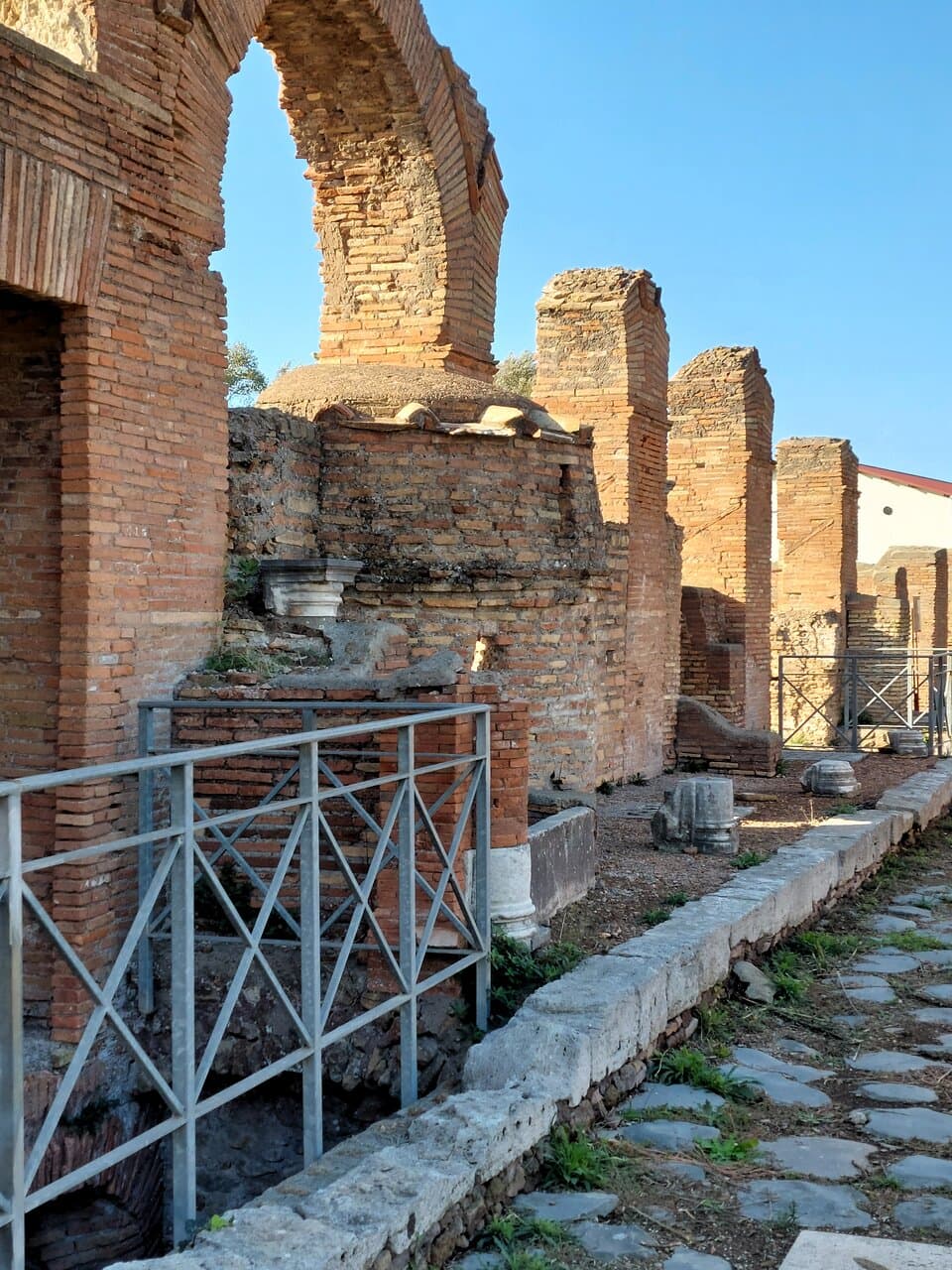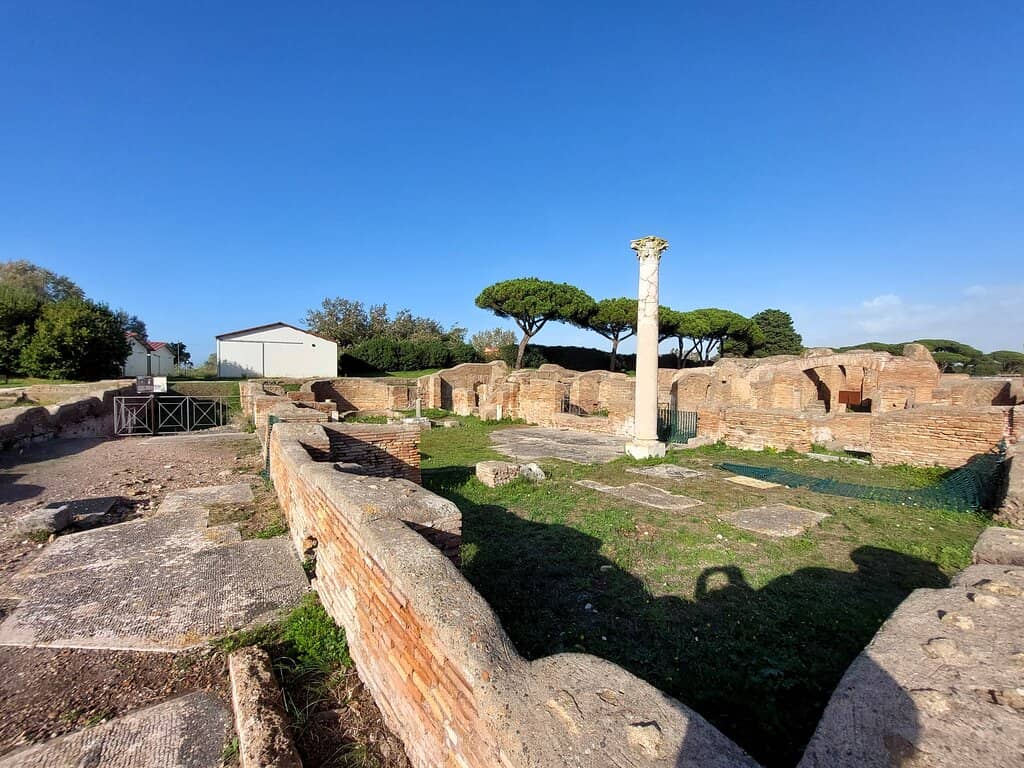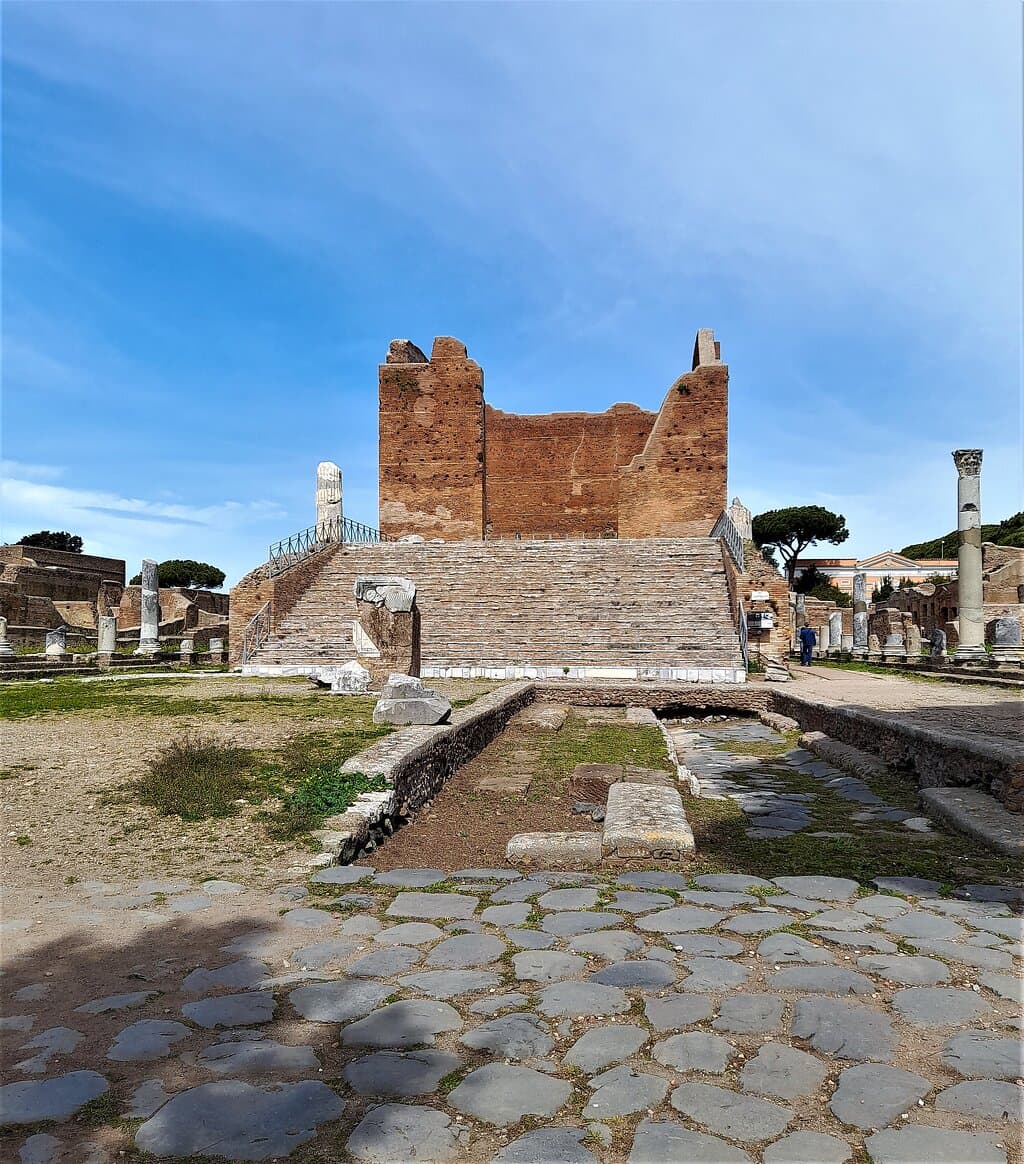
Mithraeum of Felicissimus
Discover Ostia's best-preserved Mithraic sanctuary, an evocative underground site featuring an illuminated statue of Mithras slaying a bull.

Highlights
Must-see attractions

Social
From TikTok & Reddit
Best Time
Skylight illuminates statue

Mithraeum of Felicissimus
Best Time
Skylight illuminates statue

Highlights
Must-see attractions
Discover Ostia's best-preserved Mithraic sanctuary, an evocative underground site featuring an illuminated statue of Mithras slaying a bull.
"Astonishing underground surprises await at this evocative and fascinating historical site."

🎯 Entrance is Tricky!
Look for a small gravel road past the bookshop/bar. The entrance to the underground site is a discreet staircase.
🏛️ See the Original First
Visit the Ostia Museum to see the impressive original tauroctony statue before heading to the Mithraeum.

Highlights
Discover the most iconic attractions and experiences
Mithras Slaying the Bull Statue
Underground sanctuary
A striking plaster cast of Mithras in the act of slaying a bull, illuminated by a skylight. The original is in the Ostia Museum.
Underground Sanctuary
Below the thermal baths
An evocative, barrel-vaulted underground chamber with well-preserved side benches for ancient worshippers.
Original Tauroctony Inscription
Ostia Museum
See the original inscription on the bull from the tauroctony statue, providing details about its creation.
Plans like a pro.
Thinks like you
Planning Your Visit
Finding the Hidden Gem
Understanding the Site
Best Times
Insider Tips
from TikTok, Instagram & Reddit
Under the church of San Clemente in Rome, there is a temple of Mithra from Roman times. This place of worship has been preserved almost intact and is one of the most famous preserved to our times. [564x376]
🎯 Entrance is Tricky!
Look for a small gravel road past the bookshop/bar. The entrance to the underground site is a discreet staircase.
🏛️ See the Original First
Visit the Ostia Museum to see the impressive original tauroctony statue before heading to the Mithraeum.
Going to Rome, any hidden history gems to visit?
Visiting Rome soon - Which Ancient sites should I visit? 🏛️
💡 Skylight Illumination
The underground sanctuary is lit by a skylight, making daytime visits ideal for viewing the statue.
🗺️ Use Google Maps
Navigating to the site can be challenging; Google Maps is your best bet for finding this hidden historical gem.
Looking for unkown places in Rome
Tips
from all over the internet
🎯 Entrance is Tricky!
Look for a small gravel road past the bookshop/bar. The entrance to the underground site is a discreet staircase.
🏛️ See the Original First
Visit the Ostia Museum to see the impressive original tauroctony statue before heading to the Mithraeum.
💡 Skylight Illumination
The underground sanctuary is lit by a skylight, making daytime visits ideal for viewing the statue.
🗺️ Use Google Maps
Navigating to the site can be challenging; Google Maps is your best bet for finding this hidden historical gem.
What Travellers Say
Reviews Summary
Visitors find the Mithraeum of Felicissimus to be an evocative and fascinating historical site, offering a unique glimpse into the ancient cult of Mithras. While the underground sanctuary and its illuminated statue are highlights, some note that finding the entrance can be challenging. The original statue in the Ostia Museum is also highly praised.
"Yes, another thermal complex, with some astonishing underground surprises, get there and find what I am talking about..."
Sean Eamon Cappone
"Visiting this site is evocative and fascinating. It's not the easiest thing to find, but you can get there using Google Maps. The statue of Mithras slaying the bull is illuminated by a skylight and is a cast. The original is in the museum."
Lorenzo Tognini
"I was amazed by the tauroctony statue on display in the Ostia Museum (it's enormous, the only statue of a Mithraeum I've ever seen; until now, I'd only encountered paintings, bas-reliefs, and high-reliefs, never a sculptural complex). I immediately set out to find the site, and thanks to Maps and a few directions, I was surprised: from the bookshop and bar area, a small gravel road will lead you to the site, which includes the baths at the top. A small staircase leads down to a space that—originally built under Hadrian—was later used for the cult of Mithras, after some modifications were made, such as the addition of two side seats for spectators to watch the ceremonies. The most exciting thing, thanks to the presence of a plaster cast, is the statue of the deity (in Greek robes but without the Phrygian cap) at the very back of the room and illuminated by a skylight above. Upon entering, despite the dark underground location, you're immediately greeted by the image of the bull being killed, which makes everything very evocative, even more so considering that until recently it was inaccessible and often filled with water. Thanks to the inscription on the bull (see the original inside the museum, in the cult room), we also know who created the sculpture. It's definitely worth a visit, and if you're near the museum or a restaurant, consider stopping by. Need some useful info? Like and check out my other reviews of Ostia, Rome, and more."
Roberto Cecchini
What People Like
What People Dislike
Frequently Asked Questions
🚇 🗺️ Getting There
The Mithraeum of Felicissimus is located near the Ostia Museum. While not always clearly marked, look for a small gravel road past the bookshop and bar area. Google Maps is highly recommended for navigation.
Finding the exact entrance can be a bit tricky as it's not prominently signposted. A small staircase leads down to the underground sanctuary.
You can take the Roma-Lido train from Piramide station in Rome to Ostia Antica. From there, it's a walk or short taxi ride to the archaeological site and museum.
There are parking facilities available at the Ostia Antica archaeological park, which is a short distance from the Mithraeum itself.
Many guided tours of Ostia Antica include visits to significant sites like the Mithraeum. Check with local tour operators for options.
🎫 🎫 Tickets & Entry
The Mithraeum of Felicissimus is typically accessed as part of the Ostia Antica archaeological park ticket. It's advisable to check the official Ostia Antica website for current ticketing information.
The opening hours generally align with the Ostia Antica archaeological park. It's best to verify the specific hours on the official Ostia Antica website before your visit.
Entry to the underground sanctuary is usually included with your general admission ticket to Ostia Antica.
Yes, purchasing tickets online in advance is often recommended to save time and guarantee entry, especially during peak season.
Due to its underground nature and the presence of stairs, the Mithraeum of Felicissimus may present challenges for visitors with significant mobility issues.
🎫 🏛️ Onsite Experience
The most striking feature is the plaster cast of the statue of Mithras slaying the bull, dramatically lit by a skylight. The original is housed in the Ostia Museum.
You'll find an underground chamber with a central corridor, side benches for worshippers, and the illuminated tauroctony statue. The original inscription is in the museum.
Yes, it's the best-preserved of the 17 Mithraic sanctuaries found in Ostia, offering a unique glimpse into this ancient mystery cult.
Allow about 30-45 minutes to explore the Mithraeum itself, plus additional time for the Ostia Museum and the surrounding archaeological park.
There are facilities, including restrooms and a cafe/bookshop, located near the entrance to the Ostia Antica site, which is a short walk from the Mithraeum.
📸 📸 Photography
Photography is generally allowed inside the Mithraeum, but flash photography is usually prohibited to protect the ancient artifacts. Always check for signage.
Daytime visits are best to take advantage of the skylight illuminating the main statue. The underground setting can be dim, so a good camera or phone is helpful.
The illuminated tauroctony statue is the prime photo subject. The unique underground architecture and the side benches also make for interesting shots.
Photography rules can vary in museums. Check the specific regulations at the Ostia Museum regarding the original Mithras statue.
Given the low light, consider using a wider aperture, increasing ISO slightly, and using a tripod if permitted for sharper images.
For Different Travelers
Tailored advice for your travel style
👨👩👧 Families with Kids
Tip: Combine a visit to the Mithraeum with a broader exploration of Ostia Antica. Focus on the more open and accessible areas of the park for younger children, and then perhaps visit the Ostia Museum to see the original Mithras statue. Ensure you have comfortable walking shoes and plenty of water, as the site can be extensive.
🏛️ History Buffs & Archeology Enthusiasts
Don't miss: Visiting the Ostia Museum to see the original tauroctony statue and its inscription. This provides a crucial comparison to the cast at the Mithraeum and deepens your understanding of the cult's artistic and symbolic expressions. Consider reading up on Mithraism before your visit to fully appreciate the significance of what you're seeing.
🚶 Solo Travelers
Recommendation: Pair your visit with the Ostia Museum for a comprehensive understanding. The museum provides context for the Mithraeum, and exploring Ostia Antica itself offers plenty to discover at your own pace. Having a good map and perhaps an audio guide can enhance the solo exploration.
Deep Dives
In-depth insights and expert knowledge
The Cult of Mithras
Worshippers gathered in these subterranean sanctuaries, often decorated with frescoes and altars, to perform rituals and share communal meals. The Mithraeum of Felicissimus, discovered in 1938, is particularly well-preserved. Its layout, with a central corridor flanked by benches, allowed initiates to witness ceremonies, likely including the symbolic slaying of the bull. The presence of a skylight suggests that rituals might have occurred during daylight hours, aligning with the solar aspects often associated with Mithras. The discovery of inscriptions, like the one on the bull statue (now in the Ostia Museum), provides invaluable insights into the cult's practices and the identities of its adherents.
Visiting the Mithraeum allows you to step back in time and imagine the clandestine gatherings of this fascinating ancient religion. The evocative atmosphere of the underground space, combined with the visual representation of the central myth, makes it a powerful historical site. It's a reminder of the diverse spiritual landscape of the Roman Empire and the enduring human quest for meaning and connection through shared belief systems.
Ostia Antica and its Thermal Baths
These thermal baths were not just places for hygiene but also centers for social interaction, business dealings, and relaxation. They featured various rooms with different temperatures, from frigidaria (cold rooms) to caldaria (hot rooms), and often included gymnasiums and libraries. The fact that a Mithraeum was established within or beneath such a public and bustling complex speaks to the widespread influence and integration of the cult into Roman society. It suggests that adherents could practice their faith discreetly within the very fabric of everyday Roman life.
Exploring Ostia Antica provides essential context for understanding the Mithraeum. Seeing the scale of the city, its well-preserved streets, apartments, theaters, and other temples, helps one appreciate the significance of a dedicated sanctuary like the Mithraeum of Felicissimus. It underscores how religious practices, even those considered mysterious, were woven into the urban tapestry of the Roman world.

Social
from TikTok, Instagram & Reddit